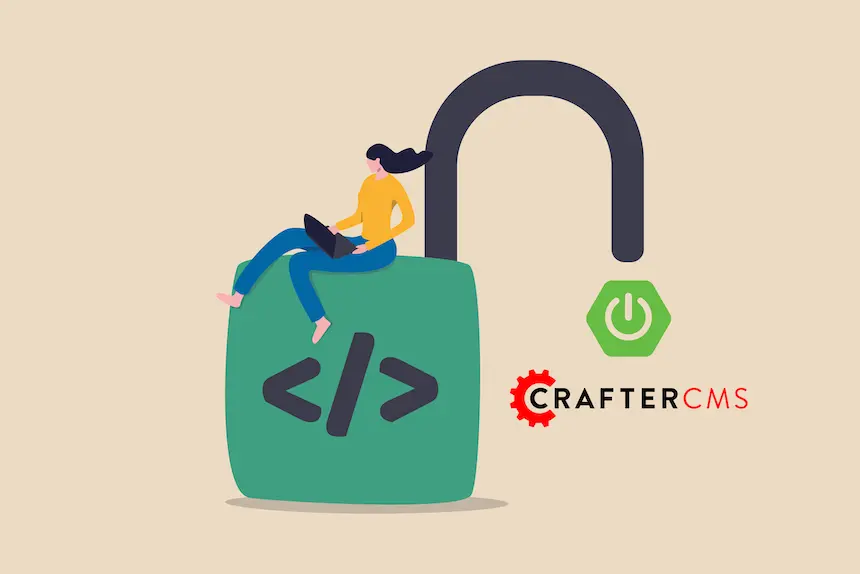Innovate Faster with a Headless CMS Built on Spring and Spring Boot

Amanda Jones

Business innovators are asked to prioritize often, and according to Forrester, should focus on ideas that deliver real business value. One area of concern should therefore be the content management system (CMS), given its importance in today’s digital landscape.
As innovation continues to be a driving force behind enterprise technology, businesses rush to come up with new ideas to meet demand, and developers are tasked with creating and deploying features fast and often. Also, content authors need to create and publish quickly and continuously.
The flexibility of a headless CMS allows developers to create frontend features using the latest and greatest tools including React, Vue and other JavaScript frameworks. A headless CMS with a microservices backend built on Spring and Spring Boot is even better, allowing more rapid innovative development and enterprise integration, all in a cloud scalable way.
A CMS built on Spring leverages Java technology to provide more security and scalability, two critical factors for mid to large enterprises.
Let’s dive a bit deeper into Spring, Spring Boot, and the benefits of these frameworks in a CMS.
What Is Spring?
The Spring Framework, or simply Spring, is an application development framework that is used for enterprise Java applications.
The framework’s features are usable for any Java application, but also allow for extensions for building web applications on the Java Enterprise Edition platform.
Spring also offers excellent infrastructure support for applications. It provides the architecture, allowing IT teams to focus their energies on finding ways to implement business logic. All of this is done without being tied down to a specific deployment environment.
Spring has several useful qualities, including many out the box modules and features like dependency injection that reduce the time developers take to build applications.
The Spring framework is divided into modules that are chosen by applications as they are needed. Each module includes a core container, a configuration model and a mechanism for dependency injection.
Support is provided for multiple application architectures, from transactional data to messaging and the web.
Now that we understand Spring, what is Spring Boot?
What Is Spring Boot?
Spring Boot is an extension of Spring, except it removes the boilerplate configuration that was needed to set up Spring applications.
It provides modern packaging for Java Enterprise Edition applications, essentially a form of containerization.
Spring Boot is an open source Java-based framework for creating a microservice, but it is not a Docker alternative. Instead, it gets packaged into Docker, creating a Java microservice in a self-contained package.
Spring Boot has some other features that differ from the Spring framework.
Start dependencies can help to simplify application configuration, and an embedded server removes the complexity when deploying applications.
Spring Boot has several advantages as a Java framework. It allows developers to set up and run web applications and microservices quickly. It also gives access to HTTP endpoints that will enable you to access an application’s internal metrics and health status.
But there are also disadvantages to Spring Boot. It includes dependencies that may not be used, which leads to a large deployment file size. If you’re working with legacy Spring applications, upgrading them to Spring Boot can be time-consuming and requires a lot of resources.
Despite these minor disadvantages, Spring Boot offers great infrastructure support for a CMS.
CrafterCMS - A Headless CMS Built on Spring and Spring Boot
Any useful CMS provides all of the functionality your company needs to get the right content in front of the right audience at the right time. But for enterprise use cases, underneath all of those features and workflows must lie a robust architecture that makes it all possible.That is what Crafter does as a Java CMS platform.
Crafter Engine, which provides content delivery services for powering any web application is extremely scalable, high-performance and dynamic. It is a Spring-based app providing a stable foundation for enterprise-grade content applications.
CMSs built in Java on the backend are the standard for the enterprise, but CrafterCMS takes it even further with its modern approach to Java-based CMS architecture.
Other CMS platforms leverage SQL databases or the Java Content Repository standard (JCR). These can be not only difficult to secure but make scaling a whole different challenge. CrafterCMS, on the other hand, uses a stateless shared-nothing architecture that is lightning-fast, and can be scaled quickly and without needing to sync or shard databases.
We have seen the power that can be obtained by using Spring technology, and CrafterCMS is built entirely on Spring. We leverage Spring Boot to create Java microservices. As a Spring platform, CrafterCMS provides Java APIs that allow backend developers to customize the system if needed.
Meanwhile, frontend developers benefit from the headless API-first approach along with CrafterCMS’s native REST and GraphQL APIs and Javascript SDK (for both client side rendering and SPAs/PWAs, and server side rendering with Nodejs). Crafter also offers Groovy scripting support, allowing developers to easily create their own RESTful content APIs.
Like Spring, CrafterCMS is licensed under open source as well.
Selecting your next CMS means that you will have to weigh a lot of different factors before you come to a decision. For enterprise requirements, the best solution can be found in a CMS that uses modern Java architecture. The Spring framework and Spring Boot architecture that CrafterCMS is built on will lay the foundation for your next generation, enterprise digital experience needs.
Learn more and download CrafterCMS today.
Related Posts

Websites Are Dead?

Mike Vertal

No-Code Experience Building for Marketers & Designers

Amanda Lee

Is Your CMS MACH-Ready? A Practical Guide for Enterprise Architects

Sara Williams

Composable DXP vs Traditional DXP: Why Enterprises Choose CrafterCMS

Amanda Jones










